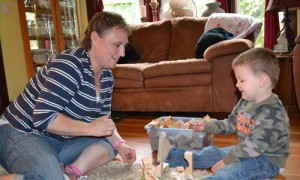
By Kristine Thomas
To ease her worries about her son’s upcoming surgery for a cleft lip and palate, Michelle Kurns worked in her garden to alleviate stress.
It was April 2013. After working in the yard, the mother of six was rubbing her left shoulder when she felt a bump.
“It was right where you place your hand when you say the Pledge of Allegiance,” Kurns, now 37, said. “I thought I pulled a muscle from working too hard in the yard.”
Laughing, she confessed she is like most women – shrugging off anything could possibly be wrong and not wanting to go to the doctor to be told what she believed she already knew – nothing was wrong.
Reluctantly, however, she went to the doctor who ran tests, and then more tests.
On May 7, 2013, she learned had Stage 2 breast cancer, with the tumor being over 3 centimeters.
“I was shocked I had cancer because I felt fine. I thought the odds of getting breast cancer were against me,” she said. “I was too young to have breast cancer, I thought, because I was only 36 years old. I wasn’t even old enough for when doctors recommend a first mammogram.”
A member of the Latter-day Saints church, Kurns said she lives a healthy lifestyle. Her research showed that her chances for having breast cancer were slim – especially since she had had two children before age 25.
As the mother of five daughters, her first concern was that maybe the breast cancer was genetic. A test ruled that out.
“I am really open about the fact I had breast cancer because I want to help other women,” she said. “It doesn’t matter your age, how healthy you are, or other things. Breast cancer can happen.”
October is National Breast Cancer Awareness Month. It’s a chance to raise awareness about the importance of early detection and encourage women to get a yearly mammogram.
According to the National Breast Cancer Inc., breast cancer is the second most common form of cancer in women. About one in eight women in the United States will get breast cancer at some point.
With early detection and the advances in treatment, many can survive breast cancer.
Dr. Chris Goeser is the medical director of diagnostic imaging at Silverton Health.
“We are recommending women have their first mammogram at around age 40 and have an annual screening,” he said.
Karen Tucker, 63, is a radiologic technologist in diagnostic imaging at Silverton Health. She’s also a breast cancer survivor.
In July of 2005, she and a colleague had their mammograms.
“I knew from looking at the film something had changed from last year,” she said. “I knew looking at it what it was. I swore and I cried.”
She has been administering mammograms for 24 years. Over the years, she knows there are women who as soon as they receive the letter that it’s time for their annual check-up, make the appointment. And then there are the women who toss the letter in the drawer and don’t think about it until they learn a friend has been diagnosed with breast cancer.
“When I learned I had breast cancer, the first thing I thought was I wanted to live to see my grandchildren grow up,” she said. “I also know I felt I was in limbo until I had a plan about what I was going to do.”
Both Tucker and Kurns advise women who have been diagnosed to talk to their physician and devise a game plan. It’s also important to surround yourself with friends and family who make you laugh and lend you support, they said.
After having a double mastectomy and chemo treatments, Kurns said she slept in a single bed in her home office because her regular bed was too high off the floor.
“I couldn’t get in the bed,” she said. “My husband, Scot, slept on the floor in the living room so he would be near by. I kept telling him he didn’t need to, but he did for three or four months.”
That kind of support and love is what made everything possible, Kurns said, adding from July to October of 2013, she had chemo treatments every other week.
“My really good friend Michelle Kelley would sit with me for three hours and we would talk and laugh,” she said. “I dreaded going to chemo because I was so sick and exhausted after it. What gave me strength is I had six kids and my husband to live for.”
Tucker had the tumor removed and underwent chemotherapy.
When a patient learns she has breast cancer, Tucker lets her know she can serve as a mentor.
“I think its important women have someone who has taken this journey to tell them they can do this and be there to listen and give advice if needed,” she said.
“I had a mentor. I could talk about everything,” she said. “I was so appreciative to have someone tell me what was happening was normal and when I was scared, to comfort me.”
“Having breast cancer is not a journey I would want anyone to take,” Tucker said. “But it is do-able. It’s not your grandmother’s or your mother’s breast cancer. The advancements in treatment have come a long way.”